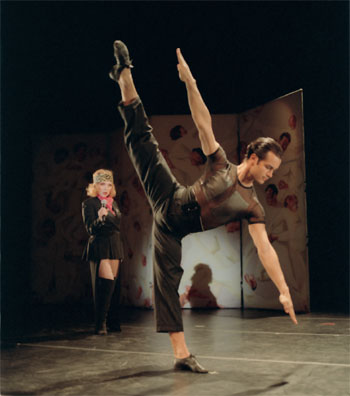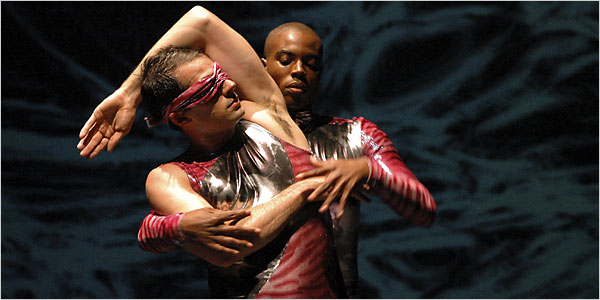 |
||||||
MoveOpolis!Press
"Feminine Beauty Is a Thing With Feathers" (review)
|
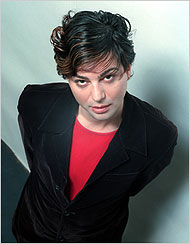 Richard Move—Josef Astor |
If you ask him, it’s not a bad résumé for someone now embarking on his latest career as a serious modern-dance choreographer. “When you look back at so many of the early moderns, in the beginning they were considered to be these maverick freaks,” Mr. Move said recently in a phone interview from Paris, where he was preparing for a performance at the Théâtre de la Ville. “You know, Ruth St. Denis had her prized peacock. Think of Ted Shawn and His Men Dancers. That was completely unheard of in the ’30s — a bunch of men dancing together? Or imagine Joseph Pilates, this genius doing exercises out in the snow in his hot pants. It all really started from this kind of wonderful madness.” |
Mr. Move’s romance with dance’s old-time, outré theatricality fed into his best-known creation: his eerily lifelike turn as Martha Graham. From 1996 to 2000, the 6-foot-4, androgynously pretty Mr. Move channeled Graham in his own dance cabaret series, “Martha@Mother,” at a down-at-heel club in the meatpacking district. His clever monologues (delivered in Graham’s breathy, clipped alto) and witty, abridged stagings of classic Graham dances drew packed houses. More important for a young choreographer, they attracted dance luminaries like Mikhail Baryshnikov, Merce Cunningham and Mark Morris.
But while Mr. Move continues to perform modified versions of “Martha” at home and on the road, he has increasingly been stepping out of her shadow. When he went to the Jacob’s Pillow Dance Festival in Massachusetts last summer, he left the Martha wig at home. Instead, he showed a full evening of his own choreography, employing a small, select company of professional dancers. A burnished version of that show, “MoveOpolis!,” arrives at Dance Theater Workshop on Tuesday.
“MoveOpolis!” is actually Mr. Move’s second full-length show in New York this year. The first, “The Show (Achilles Heels),” garnered largely positive reviews during a run at the Kitchen in April. But “The Show” was a dance-theater extravaganza, with Deborah Harry of Blondie belting into a stick mike while strolling among painted screens and lip-synching actor-dancers. “MoveOpolis!” is something very different: an evening of straight concert dance.
“It’s a risk,” said Cathy Edwards, the former artistic director of Dance Theater Workshop, who put “MoveOpolis!” on this year’s schedule. “He’s got a franchise with ‘Martha’ that he could be developing full time. That would be the safe path for Richard. But I think he wants to grow in this field. With this show, I think we’re going to get a more multidimensional iteration of his dance mind.”
Ms. Edwards, who saw “Martha@Mother” in its heyday, said she was impressed not only by Mr. Move’s passion for dance history but also by his ability to work a room. “He had the ability to bring out these crazy, beautiful, generous-spirited moments of hilarity,” she recalled. “It was as if Richard were a kind of den mother to all these widely divergent streams of the dance world.”
From his cabaret pulpit, Mr. Move served up a not inconsiderable modern-dance education along with the dish and the laughs. Real-life Graham associates like Murray Louis and Stuart Hodes dropped by the club to talk shop with Mr. Move’s Martha. Dozens of artists — including Mr. Morris, Mr. Cunningham, Meredith Monk, Molissa Fenley and Yvonne Rainer — showed work on the diminutive 7-by-10-foot stage.
“Richard made you feel a sense of community that invoked other times,” said Ella Baff, the executive director of Jacob’s Pillow, one of the insiders who squeezed into the sold-out shows. “Times you’d read about, like Greenwich Village in the ’20s, when in someone’s living room or the back of a bookstore the true spirit of uninhibited creativity was allowed to flow. Times when there was kind of a pride about being an artiste with an ‘e.’ ”
Ms. Baff noticed that Mr. Move’s gifts extended far beyond performing. He could attract extraordinary talent to his projects. He could direct, and he knew how to make a performance feel like an event. So in 2001 she invited him to be one of the choreographers of a special Jacob’s Pillow program entitled “The Seven Deadly Sins.”
Working with Helene Alexopoulos, the former New York City Ballet principal, Mr. Move created the solo “Lust.” His striking synthesis of high and low dance culture refracted ballet shapes through the prism of a dark nightclub sexuality. To many, “Lust” was a piece of bravura experimentation; Jennifer Dunning, in The New York Times, called it “stunning.” But to Mr. Move, blending modern dance with nightclub theatrics was completely natural.
“I can remember one night coming offstage at the Joyce, and then putting on a much more fabulous outfit and getting into a go-go cage and being lifted three floors above a crowd of 3,000 people at the Palladium,” he said. “The so-called legit stuff and the club work were always feeding each other,” he added. “I didn’t see one as more important than the other.”
Mr. Move’s unusual background made him an exciting artistic prospect to many, including Mr. Baryshnikov, whose White Oak Dance Project commissioned the first version of “The Show (Achilles Heels)” in 2002. In a show of faith, Mr. Baryshnikov himself first danced the role of the sensual, haughty Achilles.
“Richard’s a very New York artist,” Mr. Baryshnikov said recently from his Midtown dance studio. “It’s like that line from Anna Akhmatova, ‘poetry born from garbage.’ He emerged from the debris of downtown: from the disco life, the artists, from that dark underside of the city. And he very much gives you the impression of New York in the ’80s: the nightclub world, with its kind of simple but open, tender sexuality.”
Mr. Move’s background tells not only in his dance-making but also in the singular mix of collaborators he assembles for each project. In “Toward the Delights of the Exquisite Corpse,” one of four works on the program at Dance Theater Workshop, the slinky second-skin bodysuits are by the “Sex and the City” costume designer Patricia Field. The piece’s provocative sound score — a collage of music and spoken text by Julius Eastman and the Crystals’ chilling 1962 girl-group recording of “He Hit Me (and It Felt Like a Kiss)” — was assembled by the New Yorker writer Hilton Als. The video clips that flicker on a giant rear screen are mixed live by Charles Atlas, who met Mr. Move at a club in the early ’90s, when Mr. Atlas was working the door and Mr. Move was go-go dancing.
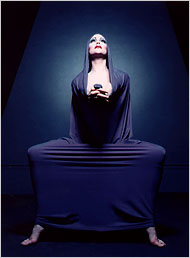 Richard Move performing as Martha Graham-Josef Astor |
Though text and video add texture
to “Exquisite Corpse,” the focus remains squarely
on the dancing. And intent on making his first “pure dance
evening,” Mr. Move has revised “Lust,” stripping
away the original’s theatrical conceits (text, mirrors,
paparazzi figures). What remains is pared-down, high-intensity
dancing for the new soloist, Catherine Cabeen. Similarly, the
other two works on the program — the solo “Dilemma”
(for Miguel Anaya) and the trio “Verdi Divertimento”
— have shed their earlier distractions for sleeker forms. Though Mr. Move doesn’t perform in “MoveOpolis,” there are echoes of his dancing in grand, archetypal gestures that — one imagines — would look even grander on his towering frame. You can sense his thirst for communication in a long gestural sequence of baby sign language. And you can almost see his intellect clicking through the floor-work experiment that opens “Exquisite Corpse.” |
But anyone who expects Mr. Move to have Graham on his mind will be surprised. Apart from a few women with long, loose hair and a mood of overall theatricality, there are few references to her. There is little of her beloved narrative, and the eclectic movement vocabulary — much of it developed in collaboration with the seasoned dancers — suggests no specific school.
Still, in other respects, Mr. Move acknowledged, Graham’s fingerprints are all over his pure-dance debut. “When I’m working, I hear these inspiring phrases of hers in my head all the time,” he said. “Things like ‘We are all of us unique, and if we do not fulfill this unique creative pattern within ourselves, it is lost forever.’ ”
![]()
Dance Review | 'Richard Move'
One of the Deadly Sins, and a Conundrum Too

Julieta Cervantes for The New York Times
Kevin Scarpin, front, and Kristen Joseph Irby in “Exquisite
Corpse.”
By JOHN ROCKWELL
Published: December 21, 2006
Richard Move’s past has been, to say the least, colorful. His present, on view at Dance Theater Workshop through Saturday, is fascinating, if not entirely fulfilling. His future would seem limitless.
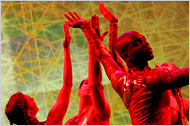
Julieta Cervantes for The New York
Times—Members of the MoveOpolis! dance troupe performing Richard
Move’s “Toward the Delights of the Exquisite Corpse”
at Dance Theater Workshop.
Best known as a Martha Graham impersonator and a fixture on the club scene, Mr. Move has been gradually asserting himself as a choreographer. Calling whatever performing forces he works with MoveOpolis!, he has staged all manner of dance events, some sprawling and bizarre (16 Greco-Roman wrestlers in Lille, France), others more conventionally modern dancey, with terrific performers drawn from the New York dance world, including a clutch of current or former Graham company members and Blondie and Mikhail Baryshnikov.
His latest venture is a career showcase of his modern-dance choreography; he himself does not perform. The first half consists of a three-part dance for a woman and two men set to music of Verdi, interspersed with two solos, “Lust” and “Dilemma.” Then, after the intermission comes a half-hour new work, flamboyantly titled “Toward the Delights of the Exquisite Corpse.”
What I mean by a limitless future but a not entirely fulfilling present is that while everything on this program bursts with mostly good ideas, his aesthetic hasn’t quite cohered yet into an individual voice. But so much is compelling, and the dancers and other collaborators are so talented, one suspects that very soon Mr. Move will put together work to make us remember his Martha as a mere footnote.
The strongest pieces on the current program are the two solos. “Lust” derives from a production of “The Seven Deadly Sins” first seen at Jacob’s Pillow in 2001. It consists of the commanding Catherine Cabeen in slow, controlled poses, glacial yet remarkably difficult to sustain in their stretched, balanced, twisted positions. Ms. Cabeen, dressed in a striking unitard by Pilar Limosner and accompanied by insistent club music from DJ Savage, looks like a goddess caught between ecstasy and terrible vengeance, frozen into a statue. The solo ends with her hands splayed and shaking and her mouth open in a silent scream.
“Dilemma” is from an opera, “Arjuna’s Dilemma,” first performed in 2003. Set to husky, evocative vocal music by Cheb Khaled, it offers the powerful, sexy Miguel Anaya, in jeans with a bare torso. Starkly illuminated from above (Donalee Katz did the lighting), he struts and runs and contorts his torso, arms and hands. The effect is seductive and scary.
The three parts of “Verdi Divertimento,” from 2004, use music from “Aida,” “Don Carlo” and “Un Ballo in Maschera.” To me this is less persuasive, if only because the power of music makes the relatively neat and clean choreography look small-scaled. It is strongly danced by Kristen Joseph Irby, Blakeley White McGuire and Kevin Scarpin.
All the dancers except for Mr. Anaya return for the new work. This ambitious construction blends their talents with the music and voice of the Minimalist composer Julius Eastman, who died in 1990, as mixed (with a song by the Crystals) by Hilton Als. There is a video by Charles Atlas of mostly patterns through which faces and birds and cityscapes emerge, and striking, reddish-orange snakeskin unitard costumes by Patricia Field with David Dalrymple.
Richard Move at Jacob’s
Pillow
by Theodore Bale
Thursday Aug 10, 2006
Right now Richard Move is best known across America for his hokey, choreographic satire for Amy Sedaris and her gang in the movie Strangers With Candy. Before that, he impressed thousands of fans in the U.S. and Europe with his post-modern vaudeville revue starring himself as the legendary Martha Graham. And before that, he was letting his body groove to the music at a wide assortment of downtown New York clubs, winning plenty of attention as a first-class go-go dancer.
What many people outside of New York or the major international dance festivals don’t know is that Move has become a formidable choreographer. He didn’t dance in his latest show, MoveOpolis!, seen last week at the prestigious Jacob’s Pillow Dance Festival in Becket, Massachusetts. And while there were ironic laughs to be enjoyed here and there, the program featured mostly non-narrative dances set to an unusual assortment of music, from Verdi to Trance from DJ Savage. With MoveOpolis!, this exciting young choreographer places himself closer to New York’s downtown dance scene. Why not? It’s where Move has based his explorations for many years. Now one shouldn’t think of his efforts as distinctly contrary to the work of other New York choreographers such as Christopher Elam, Neil Greenberg, Donna Uchizono, or even the recent work of Karole Armitage.
Move has not tried to create, from scratch, an original vocabulary of movement. Always with a keen interest in dance history, his current language contains plenty of references to classical ballet and the classic modern dance of Germany and America, if not many of the Judson Church choreographers of the 1960s. At one point dancer Kristen Irby took a pose with her torso and hips tilted, her hands as if in the gesture of playing a set of bongos. With her hair swaying side to side, she looked very much like an old postcard of Dore Hoyer performing a work by Mary Wigman. Move organizes his events according to traditional theatrical formats, providing an arc that usually results in a grand finale. In this way it’s very satisfying. What was strange was the context for each work. There were many dark moments that provoked strong emotion in the viewer, particularly in the program’s final work, the world premiere of Toward the Delights of the Exquisite Corpse.
The use of Verdi in the opening dance (Verdi for Three) was not incongruous in say, the method of director Rainer Werner Fassbinder, who used Verdi often in his films for melodramatic impact. Rather, Move used Verdi for his inescapable energy and grandeur. After a few athletic episodes of running, jumping and inspired partnering, the three dancers performed a long series of unison gestures. The dancers made fists, looking like they might be saying the pledge of allegiance, or clasped their palms together at the heart in the traditional gesture known as "anjali mudra." It was strikingly simple and quite moving, without the release of a happy ending.
The solo Lust followed, an excerpt from the evening-length Seven Deadly Sins commissioned by Jacob’s Pillow in 2001. Move knows and loves house music from his days as a go-go boy. Here he used it to create a timeless dimension in which a woman, transfixed, is at odds with the impulses of her own body. Catherine Cabeen gave this extraordinary dance a wonderfully emphatic interpretation, her face either pained or ecstatic, her body in a continual balance interrupted by inexplicable incidents that seemed to surprise even her: mouth gaping, hands shaking and reaching upward, her entire torso quivering as the dance faded into darkness.
A straightforward solo from Miguel Anaya, wearing simple pants and a little gold necklace, was set to Cheb Khaled’s rousing Arabic melodies. Originally from a multimedia opera by Wendall Harrington based on a fable from the Bhagavad-Gita (Arjuna’s Dilemma), the dance did not seem to contain any story. The movement was crisp and clear, and delivered with a slight adagio that suggested rather that the viewer should contemplate each phrase for its intrinsic beauty.
Toward the Delights of the Exquisite Corpse formed the entire second half of the program, a psychedelic and vital dance that is as perplexing as it is mesmerizing. It’s also a brilliant collaboration with the legendary video artist Charles Atlas, who provided a gorgeous wash of images relating to the body, from Hollywood film stills (Cleopatra) to layered fragments of extreme color. Hilton Als’ sound score included a speech from a man identifying himself only as a "crazy, evil nigger" and suggesting that gay men need to think more about becoming guerillas. The woman sitting in front of me started to go ballistic at the lunacy of this idea. "...They can’t really match with Afghani or PLO guerillas," he added before the dance was on to its next purpose. Two men performed a duet in silvery, space-suit costumes to the text, "you can’t accomplish anything." Then came perhaps the most difficult moment: two women in a jumpy, frenetic duet while some unidentified girl group from the 1960s sang the lyric, "he hit me, and it felt like a kiss." The energy in the house changed, people seemed on the edge of their seats. One male dancer wore a blindfold while another man positioned his obedient body in a series of mundane poses. After a series of interlacing duets, I was dizzy at this wonderful circus of images, so reminiscent of a film by one of the Kuchar brothers. The dancers spun like Dervishes, and the piece ended with a simple circle dance for the quartet.
MoveOpolis!
At Jacob’s Pillow Dance Festival, Becket, MA
August 10-13, 2006
